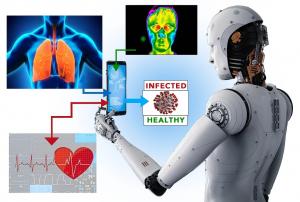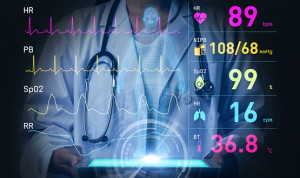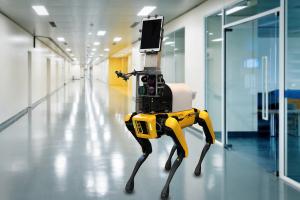Remote Monitoring of Multiple COVID-19 Symptoms: A New Era in Access Screening?
Temperature screening is insufficient to detect COVID-19 infection. Emerging technology is enabling contactless multi-symptom screening with high sensitivity.
LONDON, UNITED KINGDOM, February 8, 2021 /EINPresswire.com/ -- Since the outbreak of COVID-19 in December 2020, employee and customer screening for COVID-19 symptoms has become commonplace and, indeed, mandatory in many countries around the world. This screening has typically consisted of answering a simple questionnaire and/or having one’s temperature taken. However, experts emphasize that temperature-based screening alone is insufficient to detect COVID-19 infection.1–4 This gap, along with the need for remote monitoring of COVID-19 patients, has created a niche for new technology that can assess multiple COVID-19 symptoms simultaneously without requiring an operator or any physical contact.5–8An elevated temperature does not necessarily imply infection with COVID-19, and inversely, a person can have COVID-19 but not have a fever or any other visible symptoms of infection. In fact, temperature screening alone may miss more than 50% of persons with COVID-19.1–4
With this in mind, screening for COVID-19 should ideally assess multiple symptoms of infection. Besides an elevated temperature, other vital signs should be measured such as the heart rate, respiratory rate, oxygen saturation level, and blood pressure. When the human body is fighting an infection, there are measurable changes in these vital signs. The resting heart rate may increase and become more variable, breathing may become more rapid, body temperature may rise, and blood pressure and oxygen saturation may drop.9,10
Addressing this need for multi-symptom COVID-19 screening are recently launched systems such as Modcon’s VsScan developed in the United Kingdom, Neteera Technologies’ Neteera 1.0 developed in Israel, Soter Technologies’ SymptomSenseTM Medical Evaluation Gateway in the USA, and the ongoing Alba Vital Scan project of Alba Medical Sciences in partnership with the NHS in Scotland. These systems will likely prove particularly useful for COVID-19 screening at places where there is high foot traffic or increased risk of infection, such as airports, hospitals, border posts, shopping malls, industrial complexes, stadiums, places of education, and care homes.
Multi-symptom analyzers work by being placed next to turnstiles at points of access control. The person steps onto the demarcated spot in front of the analyzer, and once the remote scan is complete, it generates a score that determines whether the individual can continue as normal (e.g., using the “fast” route for access) or whether they need to enter the “slow” route for further assessment. Systems such as Modcon’s VsScan can perform multi-symptom assessment within a few seconds with the accuracy of standard medical devices. The company is currently undergoing FDA certification to utilize VsScan as a first-tier contactless medical diagnostic to help hospitals fight COVID-19.
This technology allows visitors to be rapidly scanned without any physical contact and without any need for assigning personnel to this high-risk task. Studies have shown that contactless vital sign measurement can achieve a performance similar to that of conventional contact medical devices (e.g., thermometer or ECG) and higher sensitivity than temperature-based screening alone.5,11,12
Are multi-symptom analyzers likely to become a necessary tool for businesses and organizations in the future? Unfortunately, experts are warning that because of factors such as human encroachment on natural habitats and increasing globalization, emerging infectious diseases such as COVID-19 are not to be considered an anomaly—instead, global epidemiological trends indicate that pathogens (mostly viruses) are more frequently being transferred from reservoirs such as wildlife to human populations.13,14 It may be prudent, therefore, to be ahead of the curve by widely implementing technologies that can be used to detect both COVID-19 and infections in general.
References
1) FDA (2020). Non-contact temperature assessment devices during the COVID-19 pandemic. Available online at: https://www.fda.gov/medical-devices/coronavirus-covid-19-and-medical-devices/non-contact-temperature-assessment-devices-during-covid-19-pandemic (last accessed February 4, 2021).
2) Bwire GM, Paulo LS. Coronavirus disease-2019: is fever an adequate screening for the returning travelers? Trop Med Health. 2020;48:14. doi:10.1186/s41182-020-00201-2
3) Quilty BJ, Clifford S, Flasche S, Eggo RM; CMMID nCoV working group. Effectiveness of airport screening at detecting travellers infected with novel coronavirus (2019-nCoV) [published correction appears in Euro Surveill. 2020 Feb;25(6):]. Euro Surveill. 2020;25(5):2000080. doi:10.2807/1560-7917.ES.2020.25.5.2000080
4) Mitra B, Luckhoff C, Mitchell RD, O'Reilly GM, Smit V, Cameron PA. Temperature screening has negligible value for control of COVID-19. Emerg Med Australas. 2020;32(5):867-869. doi:10.1111/1742-6723.13578
5) Massaroni C, Nicolò A, Schena E, Sacchetti M. Remote Respiratory Monitoring in the Time of COVID-19. Front Physiol. 2020;11:635. doi:10.3389/fphys.2020.00635
6) FDA (2020). Enforcement policy for non-invasive remote monitoring devices used to support patient monitoring during the Coronavirus Disease-2019 (COVID-19) public health emergency. Guidance for industry and Food and Drug Administration staff. Available online at: https://www.fda.gov/regulatory-information/search-fda-guidance-documents/enforcement-policy-non-invasive-remote-monitoring-devices-used-support-patient-monitoring-during (last accessed February 4, 2021).
7) Behar JA, Liu C, Kotzen K, et al. Remote health diagnosis and monitoring in the time of COVID-19. Physiol Meas. 2020;41(10):10TR01. doi:10.1088/1361-6579/abba0a
8) MIT News Office (August 31, 2020). Robot takes contact-free measurements of patients’ vital signs. Available online at: https://news.mit.edu/2020/spot-robot-vital-signs-0831 (last accessed February 4, 2021).
9) Miller DJ, Capodilupo JV, Lastella M, et al. Analyzing changes in respiratory rate to predict the risk of COVID-19 infection. PLoS One. 2020;15(12):e0243693. doi:10.1371/journal.pone.0243693
10) Isenmann A, Isenmann S. COVID-19: Symptome und Frühzeichen auch bei leichten Verlaufsformen – Bedeutung von Riechstörungen und Ruhepuls [COVID-19: Variable symptoms in mild course: olfactory loss and increased resting heart rate]. Dtsch Med Wochenschr. 2020;145(15):1095-1099. doi:10.1055/a-1190-0247
11) Negishi T, Abe S, Matsui T, et al. Contactless Vital Signs Measurement System Using RGB-Thermal Image Sensors and Its Clinical Screening Test on Patients with Seasonal Influenza. Sensors (Basel). 2020;20(8):2171. doi:10.3390/s20082171
12) Sun G, Nakayama Y, Dagdanpurev S, et al. Remote sensing of multiple vital signs using a CMOS camera-equipped infrared thermography system and its clinical application in rapidly screening patients with suspected infectious diseases. Int J Infect Dis. 2017;55:113-117. doi:10.1016/j.ijid.2017.01.007
13) Jones KE, Patel NG, Levy MA, et al. Global trends in emerging infectious diseases. Nature. 2008;451(7181):990-993. doi:10.1038/nature06536
14) Cunningham AA, Daszak P, Wood JLN. One Health, emerging infectious diseases and wildlife: two decades of progress? Philos Trans R Soc Lond B Biol Sci. 2017;372(1725):20160167. doi:10.1098/rstb.2016.0167
Natasha Beeton-Kempen, Ph.D.
Science consultant and writer
email us here
In a recent survey over 70% of people stated they are more comfortable entering a public space, that has health screening technology in place.
Legal Disclaimer:
EIN Presswire provides this news content "as is" without warranty of any kind. We do not accept any responsibility or liability for the accuracy, content, images, videos, licenses, completeness, legality, or reliability of the information contained in this article. If you have any complaints or copyright issues related to this article, kindly contact the author above.



